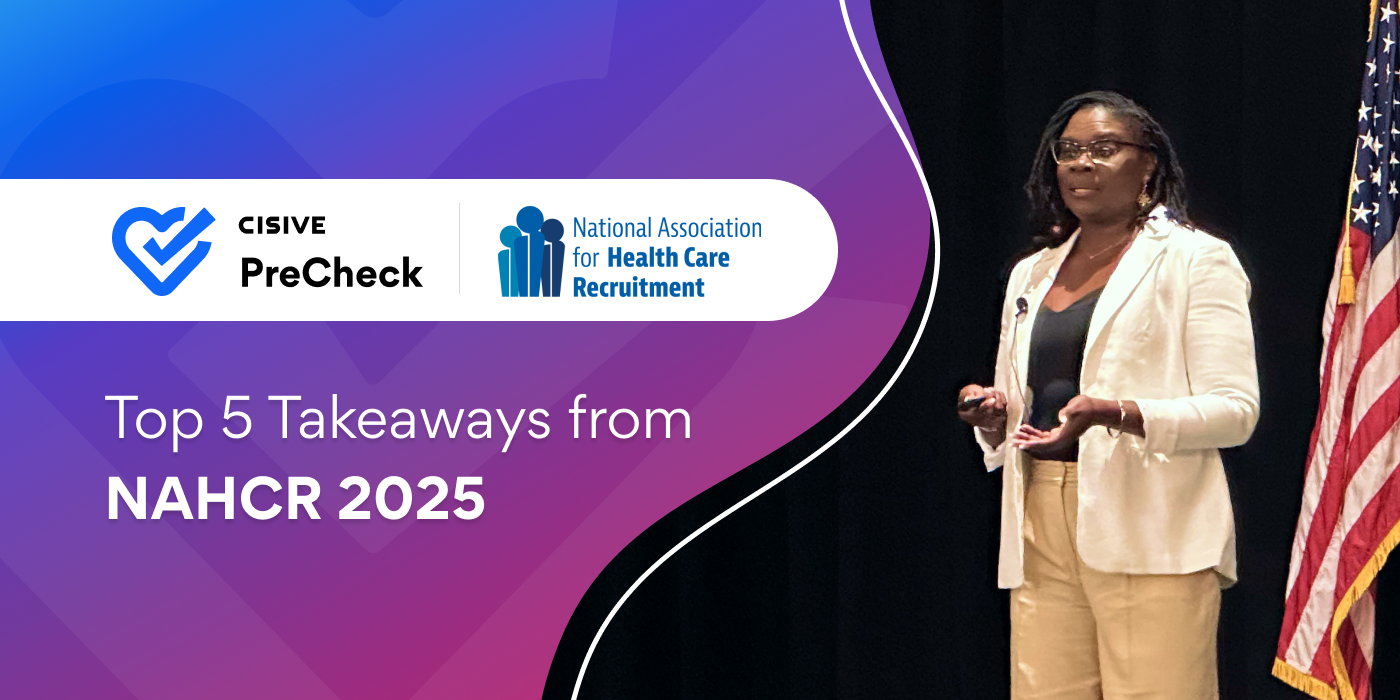

It’s official. Beginning on August 1, 2015, providers considered at “high risk” for defrauding...

Last week, I had the opportunity to attend the 50th anniversary National Association for Health Care Recruitment (NAHCR) conference in sunny Palm Springs, California. After five decades, NAHCR continues to be the only organization dedicated to healthcare recruitment and it was very special to honor its history with several past presidents in attendance. The world has changed so much in that timeframe, but the reality is you don’t have to look that far back to find drastic change.
Just 5 years after the pandemic, change has been accelerated with the emergence of remote work, and it has only been exacerbated by advancements in technology and the rise of generative AI. That’s why this year’s theme, “Recruitment R&R: Rejuvenate and Refresh Your Recruitment Strategies,” is more relevant than ever. Maintaining the status quo is no longer an option. Updating your recruitment strategy in an AI-driven world is essential.
And without further ado, here are my favorite takeaways from the 2025 NAHCR conference.

I found this year’s opening keynote from April Lewis both inspiring and reinvigorating. Lewis, who serves as President and CEO of the A. Lewis Academy, shared her secret for a recruitment refresh and how we can get back to what she calls Day One Energy (DOE). “There’s been a shift in how we connect with each other,” she explains. “The art and science of being a human is being diminished by technology in today’s world. It is the smallest things that we overlook in this highly technological world that can make a difference.”
According to Lewis, there are 3 critical places healthcare recruitment professionals should focus on to work well:
Embody the Mindset – The easiest way to achieve this is to be present in everything you do. When you’re on a phone call or email, let that person or those people be the center of your universe. “You are human and there will be days when you do drift away because you have a lot on your mind,” she says. “Come back into the present moment and see how critical your role is.”
Encourage Movement & Rest – Don’t ignore the importance of physical health and rest. According to research, only 4 out of 10 Americans get enough physical activity to be healthy. “Take care of your body not because of the aesthetic but because this is the template that you take into the workplace,” Lewis explains. And research suggests that just 20 minutes of movement can boost cognitive performance by 20%.
But physical exercise is only part of the equation. Quality sleep can improve decision-making by 50%. “Time is a fixed construct, but you can manage your energy,” Lewis says. “Get enough rest so that you can stay awake and have a stable amount of energy the next day. Model the behavior of being well so that you can show up and be present in your work.”
Execute with Intention – Remember that everything that you do should have a purpose behind it. “Anything worth doing is worth doing well,” Lewis states. “I want you to be so intentional about everything that you get ready to do. You can’t always create the outcome that you desire, but you can always control the input.”
Taking the time to think about the reason behind each task on your to-do-list can make a big difference. “Whatever your role is, be the CEO of that role,” Lewis explains. “There’s a different level of ownership when you work like that. Own your work: it will activate intrinsic motivation. On the days when things are tough, you must be able to tap in and pull something out of you that keeps you going.”
Before concluding, Lewis reminded attendees about the importance of the human side of healthcare recruitment. “There is nothing more that we need in healthcare right now than people who care,” Lewis stresses. “Humanity is suffering right now, but you are placing people into a role where they are saving lives. It’s such a big deal!”
Thursday’s keynote speaker Charlie Saffro discussed how small actions and hard choices can shape us and others. As CEO and Founder of CS Recruiting, Saffro shared stories from her personal background and professional experience as a recruiter and leader. She also provided a definition of influence from her 103-year-old grandmother Ruth: “Influence is when you life your life in a way that inspires others to live their lives differently.”
Staffo reminds us that our small behaviors and everyday actions are influencing people whether we intend to or not. “Every decision, every comment that we share has the power to influence other people,” she explains. “When we influence we create these ripples.”
Recommended Reading: Looking to update your summer reading list? If you haven’t already, consider adding The Gift of Influence by Tommy Spaulding, recommended by Saffro herself.
As recruiters, you play a key role that helps set the tone for candidates from their first interactions with your organization. “Our role, no matter where we are in the process, is truly to make business personal and to bring that human front and center,” Saffro stresses. “It also trickles into the company culture. In my 25 years in both recruiting and leadership, I have seen how ripples can create this impact so much bigger than we can ever imagine.”
The latest research by Gallup suggests that 8 out of 10 people in the workforce say they are disengaged (2025 Workforce Report). To combat this workforce challenge, Staffo shared a 3-pronged approach to creating ripples that matter:
Show Up – Put yourself out there, even before you feel ready. Ask yourself: ‘What am I doing every day to show up and how can I make a bigger difference?’ “Think about all these instances where you almost didn’t show up,” Saffro says. “It’s putting yourself out of your comfort zone.”
Lift Up – Create connection through small, intentional acts. The power of being a recruiter is all about connections. Lifting others can be as simple as leaving an encouraging sticky note on a colleague’s desk. “When we went remote, I started sending post cards in the mail,” Saffro shares. “Be human first, and you’ll be better professionals.”
Own Up – Act with integrity even when it feels next to impossible. “How many times have we had to reject a candidate and we just avoided that call because you don’t have feedback to give them?” Saffro asks. “It’s owning up to these situations with integrity, honesty, and vulnerability.”
While Lewis’ lesson provides us with a foundation to empower us to show up and work well, the NAHCR conference is also packed with practical insights for healthcare recruitment. One of my favorite sessions from the conference was titled “Proactive Talent Acquisition: Leveraging Social Listening to Connect with Top Talent and Market Disruptions.” By integrating predictive analytics, competitive intelligence, and targeted outreach, healthcare recruiters can advance their recruitment strategy by following Yvette Hansen’s proactive approach. As Director of Belonging & Talent Attraction at Baylor Scott and White Health, Hansen shared how her organization leverages social listening to attract candidates impacted from talent disruptions.
Hansen defines talent disruption as anything that happens to an organization that affects the talent population, which could range from a change in staffing models and mergers & acquisitions to massive layoffs or downsizing. Hansen partnered with her corporate social team to gain access to a social listening tool that can monitor the public world wide web and provide timely reports based on keywords such as “hospital layoffs” or “downsizing.”
Tip: You may not need to invest additional budget to leverage this tool. Talk to your marketing or social media team. You may be able to get access to a social listening tool that your organization may already be using.
To develop her proactive recruitment plan, Hansen involved the Sourcing, Recruiting, Leadership, & Recruitment Marketing teams to implement her strategy. “From a sourcing perspective, we have to focus on priorities,” Hansen explains. “If a competitor is having a layoff, that should be top priority.”
Tip: Focus on sourcing talent who are being affected. Consider activating your employee referral program and promote it with team members who have worked previously with the competitor/organization going through the disruption or layoff.
Hansen also stressed the importance of reporting to measure her organization’s progress. Her team focused on logging activities to enable reporting on the output from the disruptions. “The CRM and Microsoft Teams Planner is where we log all the disruptions,” she explains. “We just used what we already have.”
Tip: Enable your Recruitment Marketing team with access to Meta and geo-fencing campaigns. Consider running targeted campaigns around the physical location of a facility.
Finally, Hansen reminds us that your recruitment strategy is an evolving process. “There’s still opportunities to improve,” she says. “To take a theoretical process and put it into action is one thing, but to take it and improve it is another.”
Tip: Continually review your recruitment strategy for opportunities to improve. Specifically, consider what areas could be improved via automation: from reporting and tracking to integrating social listening tools to trigger marketing efforts.

If you’re working on adjusting your recruitment strategy for the digital age, then you may find the takeaways from this next breakout session helpful. Christy Bray, Chief Customer Officer at PracticeLink and Salvatore Christlieb, Senior Physician Recruiter at Baptist Health led a session discussing how to use the D-R-I-V-E framework to master recruitment:
Data – Use metrics to maximize ROI. How many applicants are you getting from which sources? “The goal here is to improve your talent attraction and be where your candidates are,” Christlieb says. “Think about how do we reduce time-to-fill?”
Recruitment Marketing – Use a marketing approach. The key is to have a relationship with your marketing team. While there will be growing pains, it’s critical to partner together across your organization. “The secret sauce that we have is the videographer on our team that creates videos for our job postings,” Christlieb shares.
Innovation – Reimagine technology. Consider combining traditional print postcards with digital by adding a QR code that you can track. Geo-fencing campaigns can help keep your brand fresh and stay top of mind for physicians and other candidates. “I do geo-fencing around conferences,” Christlieb says. “I target their homes on every single device from a PS5 all the way to their iPhone.”
Visibility – Optimize job posts. Try to make it mobile-friendly and give candidates the highlights. According to research, job seekers are 25% more likely to apply to job postings with salary details. “Figure out the points that matter the most,” Christlieb says. “There are certain themes that come up depending on the role such as quality of time, block time, and flexible schedule.”
Experience – Streamline processes. Consider simplifying your application, because you may be driving people away. Don’t bury your career page seven clicks within your website. “Specialists are quick to look elsewhere if not contacted within 48 hours after applying,” Christlieb explains. “Get in front of them and used automated tools to respond and ask them to schedule time with you on the calendar. If you’re not using Bookings or Calendly, putting that in your signature line is a game changer.”
Although there are many AI tools such as RODES, Grammarly, and Maestro to consider, the presenters also stressed the importance of maintaining the human element in your recruitment. “AI will never replace the conversations you have with your candidates,” Christlieb states.
In their session, presenters Chris Sund, President and COO at Uniti Med and Emily Walsh, Education Director at NAHCR, shared a few ways recruiters can not only handle hiring objections but also shift those conversations into opportunities. To introduce his presentation, Sund shared the following quote from John Maxwell: “It’s not our job to win the conversation—it’s to win their trust.”
Every objection is a chance to build trust. Sund explains that navigating objections is not something we encounter only work, but it’s something that we can also apply in our personal lives at home. By anticipating a candidate’s concerns and objections, recruiters can:
Build trust early.
Reduce drop-off and ghosting.
Differentiate yourself from other recruiters.
Create a smoother decision path.
Help you stay in control of the conversation.
As a Nurse Recruiter at UMC Health System, Walsh shared some of the challenges she faces recruiting nurse graduates in Lubbock. “It’s hard to get candidates that are not local,” she explains. “Location and pay are top challenges. A lot of them are from bigger metroplexes and don’t want to stay in Lubbock, so you lean into heavily selling the lifestyle, not just the job.”
Tip: Hone in on transparency and building trust early with candidates. Take the time to nurture relationships. “I really love that I can build that relationship with graduate nurses and carry it through their career,” Walsh says.

Sund is a proponent of the LAARC Method and shared how to apply it to healthcare recruitment:
Listen – Focus on listening to understand the candidate. “We have an innate desire as humans to want to be heard,” Sund explains. “Focus on [candidates’] need to talk. They should be doing most of the talking.” Give the person some space, avoid interrupting, and show active body listening.
Acknowledge the Objection – Ensure the candidate knows you heard them. Repeat or summarize their concern. Validate their perspective even if you don’t agree. This helps prevent defensiveness.
Ask a Question – Use open-ended questions to clarify the objection. “Objections are like an onion, there are more layers to it,” Sund says. “When you ask something, you usually only get the surface but there is much more to it.” Asking follow-up questions gives you a chance to steer the conversation.
Respond to the Objection – After you have acknowledged the objection, it is your chance to respond and reframe it.
Confirm the Objection was Handled – Don’t end the conversation without ensuring you are fully aligned with the candidate. Summarize the agreement and next steps, clarify any concerns, and prevent potential misunderstandings.
Now that you understand the methodology, it’s time to put it into action and apply it. “The biggest thing comes down to whether or not you apply it,” Sund concludes. “It’s building a habit. What is something you can do a little bit better? That’s what you can focus on for the next few weeks.”
I hope you found these takeaways from this year’s NAHCR conference insightful. As Communications Director for NAHCR, I hope you’ll join us in Milwaukee, Wisconsin for next year’s conference from July 12-16, 2026! In the meantime, check out NAHCR’s recently launched podcast, The Hiring Scope, for more talent insights. With 2 seasons on the way, it’s a great way to keep learning and stay connected with NAHCR throughout the year.
Author: Bryan Barajas
Bio: Senior Director of Marketing Operations, Cisive. Music Enthusiast, Indoor Cycling Coach.
Let's Connect on LinkedIn
It’s official. Beginning on August 1, 2015, providers considered at “high risk” for defrauding...

A labor shortage in the healthcare industry, from front desk workers and medical technicians to...
.jpg?height=200&name=BLOG%20IMAGE_%20Primary%20Source%20License%20Verifications%20(PreCheck).jpg)
Several years ago, my colleague Vu T. Do, PreCheck’s Vice President of Compliance, discussed a...